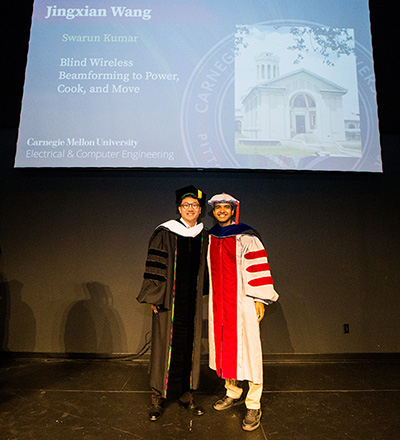
Wireless Beamforming
By Emma Skidmore
Media InquiriesFor ECE Ph.D. alumnus Jingxian Wang wireless signal means more than just communication.
Electrical and Computer Engineering Ph.D. alumnus Jingxian Wang has been awarded the ACM SIGMOBILE award for his thesis, “Blind Wireless Beamforming to Power, Heat, and Move,” which explores ways in which blind beamforming systems can deliver precise energy to battery-free devices.
“Beamforming is a technique to focus wireless energy toward a particular direction, like a laser beam, instead of diffusing the energy in all directions,” Wang, a research scientist at Microsoft Research and an adjunct professor at the National University of Singapore, explained.
This highly competitive award recognizes the best Ph.D. dissertation among nominees in all areas of ACM SIGMOBILE globally including mobile computing, wireless networks, sensing systems, and more.
Wang used the example of a microwave to illustrate beamforming technology and its imperfection, especially when used with objects that can’t give feedback like food.
“Sometimes it overheats the food, and sometimes it can’t heat the food,” he said. “We found that we can use the beamforming technology that we developed, which can precisely deliver the energy to an object.”
Wang explained his research was informed through a problem-based approach.
“Jingxian has been broadly the creative force behind pretty much all of his work,” said Swarun Kumar, professor of electrical and computer engineering and Wang’s thesis advisor. “I would say it’s very problem-dependent. I think, in Jingxian’s case, the pattern I’ve observed is solving everyday problems.”
Instead of focusing on wireless communication, Kumar explained how Wang’s work is more focused on using wireless capabilities “to effectively power things from a distance.” In terms of real-world application, this technology could mean tracking bags through the airport so they don’t get lost, or tracking athletes on a field without bulky sensors.
“All of this fortuitously emerged—the common theme of finding interesting ways in which many, many different devices can work with each other not to beam information, but to beam energy,” Kumar said. “That became a fairly fundamental contribution to the field.”
Wang and Kumar both said a simultaneous challenge and benefit of the research was that it was interdisciplinary. Wang explained how researchers across other disciplines helped him create unique ideas and solve problems, and he recommended this avenue to other students conducting or publishing research.
“That's a lot of where the magic happens—at the intersection of disciplines,” Kumar said.
In the future, Wang hopes to develop a 3-D printing mechanism to improve the efficiency of additive manufacturing. He also hopes to develop ways wireless energy is applied to medical treatments, such as non-invasive cancer treatments and nerve stimulation.
“This is research that is a fusion of wireless systems with diverse, yet complementary, fields,” Wang said.
